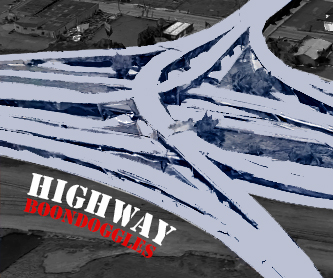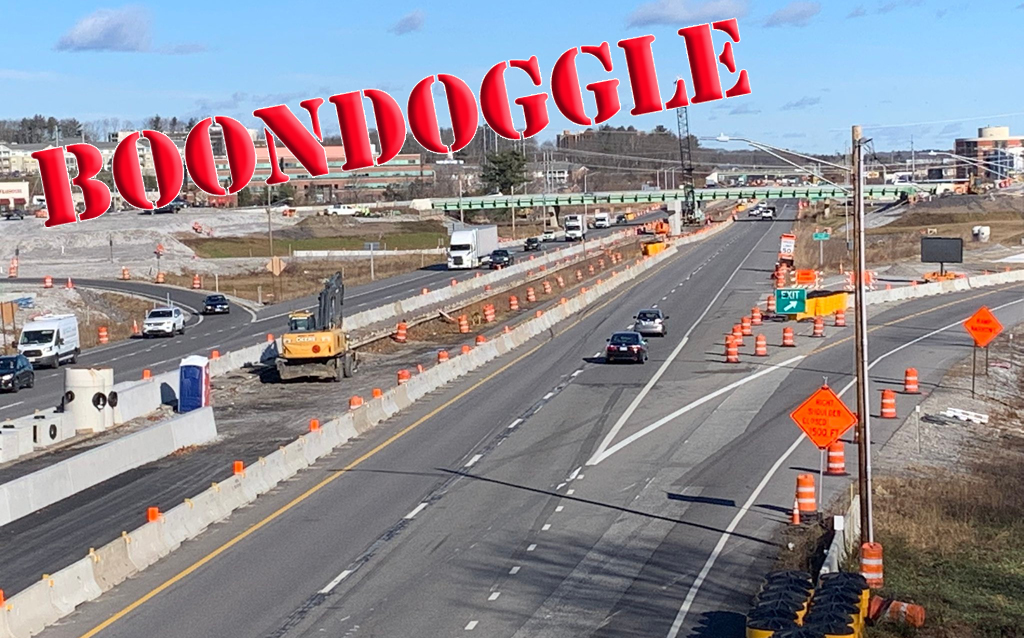This article is a part of our annual Highway Boondoggles series in partnership with U.S. Public Interest Research Group. Click here to read the other articles in the series as they are published.
Gorham Connector, Maine
Cost: $220-$240 million

Generally speaking, Maine has largely avoided making highway-sprawl mistakes on the scale seen in other parts of the country. However, residents of Portland and its environs fear that this could be about to change.
The Maine Turnpike Authority has proposed building a new six-mile, four-lane limited access highway spur linking Gorham and Westbrook to South Portland and the rest of the I-295 infrastructure that cuts through Portland’s downtown. Slated to cost at least $200 million, this new highway would link the Maine Turnpike at Exit 45 to the Gorham Bypass off Route 114 in Gorham, with the claimed objective of relieving congestion on the two existing two-lane roads between Gorham and Westbrook and Portland.
The idea of creating improved highway connections between Portland and areas west of the city has been around for decades — and it is not entirely unpopular among local residents. Currently there are no highways leading west or northwest from Portland toward the towns in its vicinity, which have been growing rapidly due to sprawl-conducive land-use policies. Formerly self-contained towns like Westbrook and Gorham, and the once-rural adjoining towns, are increasingly becoming dormitory towns for Portland. As a result, existing roads into the city experience some moderately slowed speeds due to congestion. In 2012, a feasibility study commissioned by the Turnpike Authority to study the possibility of a new connector linking the Gorham Bypass with the Maine Turnpike proposed — among other things — a new road.
However, the study also explicitly states that that road will not solve the traffic problem.
Rather, the authors stress that for any such project to succeed it would need to be combined with an effective regional public transportation strategy that would create a substantial increase in transit ridership and bus routes, as well as land-use policies that direct growth away from single-family homes on large lots and instead create pockets of housing and commercial density that would make transit a feasible and cost effective travel option. (As it is, Gorham and Westbrook are served by just two bus lines to Portland, both of which travel in traffic, with no signal prioritization, bus lanes, or any other enhancements to speed service.)
A decade later, despite the governor’s stated commitment to mitigating climate change and limited progress on transit projects and land use changes in the area, MTA is pressing ahead with its highway.
In November 2019, the MTA Board authorized MTA to proceed with the initial environmental studies, selected land acquisition and public outreach planning for the project. In 2022, MTA reconstructed the turnpike’s Exit 45 interchange to “accommodate growing traffic numbers,” apparently laying the groundwork for a future Gorham Spur. As of August 2023, the agency was working to determine financial feasibility and gathering information necessary to establish possible routes for the highway prior to deciding whether to pursue a permit from the U.S. Army Corps of Engineers and Maine Department of Environmental Protection.
The exact route has not been decided, but initial plans indicate that it would likely require the destruction of part of the Gorham Country Club golf course and the demolition of several homes in the area. In 2021, MTA was anticipating the route impacting homes in Gorham and Scarborough, where the agency had already preemptively acquired several parcels of land.
By June 2023, having “basically completed” its process of identifying the most viable route and purchased most of the homes it envisages being demolished, MTA is engaged in “identifying significant environmental impacts, especially to wetlands.” That their “wetlands mitigation plans” will “likely include creating new freshwater wetlands somewhere in the area” suggests that the proposed route will cause significant damage to existing wetland habitats.
The road may also cut through or near Smiling Hill Farm, a local dairy, ice cream parlor and petting zoo beloved by generations of children. In 2021, the farm issued a statement opposing the project, saying “one of our greatest fears is now a reality — a drastic change to our rural farm way of life.”

As MTA pushes ahead with the project, a rising chorus of voices has been speaking out against it. In 2022, Portland City Council unanimously passed a resolution calling on the MTA to stop its work on the highway until rapid transit options have been properly examined as an alternative way of reducing traffic. The council argued that a new highway runs counter to local and state plans to combat climate change and called for any final decision on the project to be consistent with Maine’s emissions reductions goals.
These sentiments are echoed in a 2022 editorial in the Portland Press Herald, whose editorial board argued that “land-use planning reform and a transit study should come before construction of a $200 million-plus highway project.” The article notes that congestion in Westbrook, Scarborough, Standish and Gorham is the result of “decades of economic pressure that make people look to once-rural areas for more-affordable housing.”
The low-density development that ensued, and the increase in car travel that this created, put added strain on roads not designed to handle this increased traffic volume. “Without allowing for denser development and offering a real transit alternative,” the editors argue, “building a faster road from Gorham to Portland could simply drive the development further west.”
In 2022, GrowSmart Maine — a statewide non-profit advocating for the integration of smart growth principles in community planning — likewise came out against the proposal, arguing that while “ongoing traffic issues” are real, these issues are not going to be solved by building a new highway. Being the result of “multiple longtime factors,” they require a “multi-prong solution,” and that solution must start with “land-use planning that directs most new development to walkable districts in targeted growth areas and lays the groundwork for more transit options.”
Indeed, the Greater Portland Council of Governments recently received $800,000 in federal funding to assess the possibilities for transit along the corridor – specifically, a rail or bus rapid-transit link between Gorham and Portland. The towns served by these proposals have become home to many low-income residents, including immigrants and blue-collar workers priced out of Portland’s real estate market – residents who would benefit greatly from improved bus service. Instead of waiting for the results of the GPCOG study, however, MTA appears to be powering ahead with the new highway.
No official budget has yet been released, but in November 2021, MTA Executive Director Peter Mills said he anticipated the project to cost “at least $220 million,” possibly up to $240 million. Thanks to a cap imposed by the Legislature in 2017, MTA can borrow up to $150 million for the project, with the remainder of the costs to be covered by a combination of revenues and bonds, plus funds from combined turnpike reserve accounts. As of June 2023, MTA claims that the project will not use any state or federal highway dollars.
In sum, opponents of the new highway argue that this is a self-defeating project that will merely exacerbate suburban sprawl – in other words, reinforce the very conditions that are causing the traffic problems in the first place – and hence increase air pollution and carbon emissions in surrounding communities.






